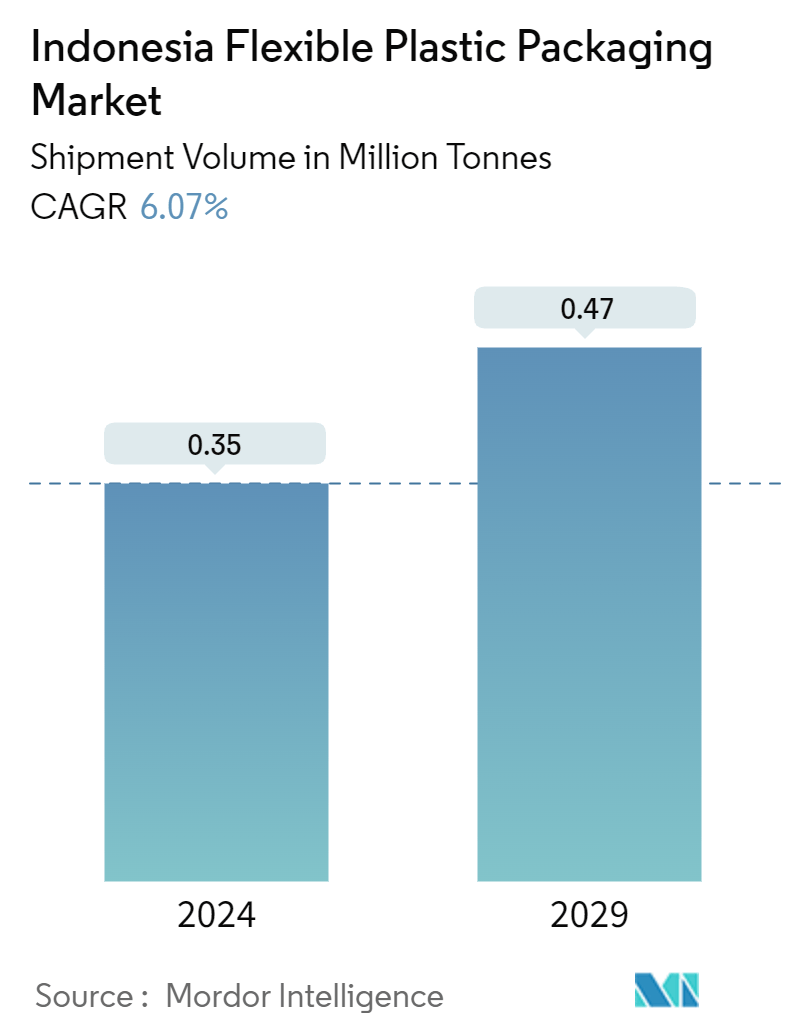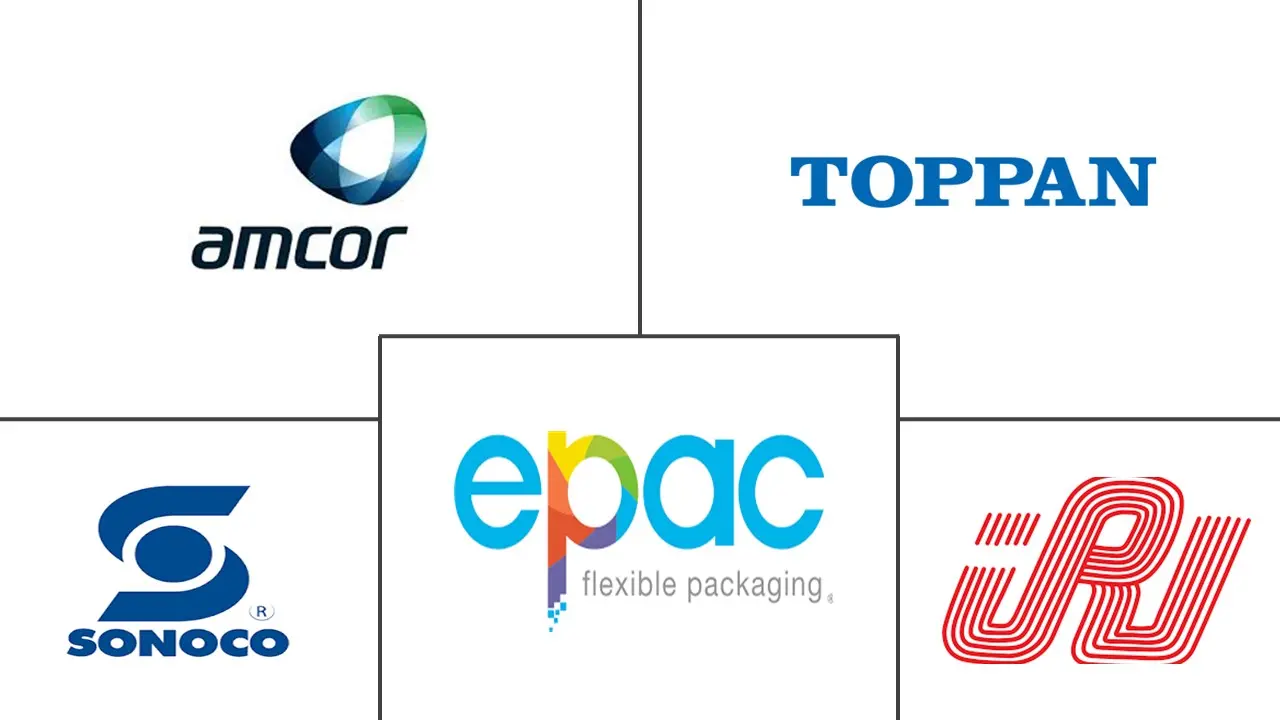Market Size of Indonesia Flexible Plastic Packaging Industry

| Study Period | 2019 - 2029 |
| Base Year For Estimation | 2023 |
| Forecast Data Period | 2024 - 2029 |
| Historical Data Period | 2019 - 2022 |
| CAGR (2024 - 2029) | 6.07 % |
| Market Concentration | Low |
Major Players
*Disclaimer: Major Players sorted in no particular order |
Indonesia Flexible Plastic Packaging Market Analysis
The Indonesia Flexible Plastic Packaging Market size in terms of shipment volume is expected to grow from 0.35 Million tonnes in 2024 to 0.47 Million tonnes by 2029, at a CAGR of 6.07% during the forecast period (2024-2029).
Changes in consumer preferences are poised to propel Indonesia's flexible plastic packaging market. Consumers increasingly favor on-the-go food options, and the demand for single-serve and ready-to-eat packaged foods is surging.
- Indonesia's flexible packaging market is pivotal as the nation pivots toward sustainability. There is a notable shift from single-layer plastics to eco-friendly options like multi-layer, high-barrier, recyclable materials. Driven by a growing population and a surging demand for affordable packaging, Indonesia's flexible plastic packaging market is thriving.
- The growth of the Indonesian flexible plastic market is mainly driven by the country's growing population and increasing demand for low-cost, lightweight, flexible packaging. According to the International Monetary Fund (IMF), Indonesia's population is expected to reach 274.85 million in 2022. IMF also anticipates that Indonesia will be one of the world's largest economies by 2030. Moreover, increasing urbanization is contributing positively to the growth of the market. Due to the economic development of Indonesia, the production and consumption of flexible plastic packaging products are growing steadily yearly.
- In Indonesia, millennial consumers are spearheading the surge in demand for flexible plastic packaging. This demographic favors single-serving and on-the-go food options, prompting the market to craft portable, durable, and lightweight products. Flexible plastic packaging is the prime packaging solution. Consumer expenditure on various food items, spanning bakery goods, ready meals, and snacks, has witnessed a significant uptick in recent years.
- According to In Corp Indonesia, in June 2024, there was a notable surge in demand for pillow pouches, primarily propelled by their expanding applications in the food, beverage, and dairy industries. These pouches stand out for their economical pricing, effective sealing, and streamlined transport, bolstering their market acceptance. Indonesia's food industry also presents enticing prospects, with emerging trends pointing toward a robust growth trajectory.
- Consumers in the country are aware of the environmental repercussions of single-use plastics and unsustainable business practices and seek products with a more positive ecological footprint. However, despite this trend, many companies and entrepreneurs flood the market with polluting packaging materials. The consequences are threatening, ranging from plastic clogging waterways and exacerbating flooding to posing significant health risks to humans.
Indonesia Flexible Plastic Packaging Industry Segmentation
The study on the Indonesian flexible plastic packaging market tracks the demand for flexible plastic packaging by material in terms of revenue. It tracks the market size for respective end-user types. The estimates for the Japan flexible plastic packaging market include all the costs associated with flexible plastic packaging manufacturing, from raw material procurement to end-use industries. The estimates exclude the cost of the content that is or is to be packed inside the flexible plastic packaging. The scope of the flexible plastic packaging market is limited to B2B demand. Market numbers are based on bottom-up and top-down approaches for segmentation, and volume has also been considered.
The Indonesia Flexible Plastic Packaging Market Report is Segmented by Material (Polyethene [PE], Bi-Oriented Polypropylene [BOPP], Cast Polypropylene [CPP], Polyvinyl Chloride [PVC], Ethylene Vinyl Alcohol [EVOH], and Other Material Types [Polycarbonate, PHA, PLA, Acrylic, and ABS]), Product Type (Pouches, Bags, Films and Wraps, and Other Product Types), End-User Industry (Food [Frozen Food, Dry Food, Meat, Poultry, and Sea Food, Candy & Confectionery, Pet Food, Dairy Products, Fresh Produce and Other Food (Seasonings & Spices, Spreadables, Sauces, Condiments, etc.)], Beverage, Medical and Pharmaceutical, Personal Care and Household Care, and Other End User Industry [Automotive, Chemical, Agriculture ]). The market sizes and forecasts are provided in terms of volume (tonnes) for all the above segments.
| By Material Type | |
| Polyethene (PE) | |
| Bi-oriented Polypropylene (BOPP) | |
| Cast Polypropylene (CPP) | |
| Polyvinyl Chloride (PVC) | |
| Ethylene Vinyl Alcohol (EVOH) | |
| Other Material Types (Polycarbonate, PHA, PLA, Acrylic, and ABS) |
| By Product Type | |
| Pouches | |
| Bags | |
| Films and Wraps | |
| Other Product Types (Blister Packs, Liners, etc) |
| By End-User Industry | ||||||||||
| ||||||||||
| Beverage | ||||||||||
| Medical and Pharmaceutical | ||||||||||
| Personal Care and Household Care | ||||||||||
| Other End user Industries ( Automotive, Chemical, Agriculture) |
Indonesia Flexible Plastic Packaging Market Size Summary
The Indonesian flexible plastic packaging market is experiencing significant growth, driven by evolving consumer preferences and demographic shifts. As consumers increasingly favor on-the-go and ready-to-eat food options, the demand for flexible packaging solutions is surging. This trend is further supported by the country's growing population and urbanization, which are contributing to the rising need for affordable, lightweight, and durable packaging. The market is also witnessing a shift towards more sustainable packaging solutions, with a move from single-layer plastics to multi-layer, high-barrier, and recyclable materials. This transition is aligned with the broader global emphasis on sustainability and environmental responsibility.
The market landscape is characterized by a mix of domestic and international players, such as Amcor PLC, PT Toppan Indonesia Printing, and Sonoco Products Company, who are actively expanding their presence through strategic collaborations and product innovations. The food industry, particularly packaged food sales, is a major end-user, with increasing consumer expenditure on prepared meals, bakery products, and snacks driving demand for flexible plastic packaging. The rise of e-commerce and the need for visually appealing packaging further bolster market growth. Additionally, the market is poised for continued expansion as companies like Amcor and PepsiCo make significant investments to enhance their operations and product offerings in Indonesia.
Indonesia Flexible Plastic Packaging Market Size - Table of Contents
-
1. MARKET INSIGHTS
-
1.1 Market Overview
-
1.2 Industry Attractiveness - Porter's Five Force Analysis
-
1.2.1 Bargaining Power of Suppliers
-
1.2.2 Bargaining Power of Buyers
-
1.2.3 Threat of New Entrants
-
1.2.4 Threat of Substitute Products
-
1.2.5 Intensity of Competitive Rivalry
-
-
1.3 Industry Value Chain Analysis
-
-
2. MARKET SEGMENTATION
-
2.1 By Material Type
-
2.1.1 Polyethene (PE)
-
2.1.2 Bi-oriented Polypropylene (BOPP)
-
2.1.3 Cast Polypropylene (CPP)
-
2.1.4 Polyvinyl Chloride (PVC)
-
2.1.5 Ethylene Vinyl Alcohol (EVOH)
-
2.1.6 Other Material Types (Polycarbonate, PHA, PLA, Acrylic, and ABS)
-
-
2.2 By Product Type
-
2.2.1 Pouches
-
2.2.2 Bags
-
2.2.3 Films and Wraps
-
2.2.4 Other Product Types (Blister Packs, Liners, etc)
-
-
2.3 By End-User Industry
-
2.3.1 Food
-
2.3.1.1 Candy & Confectionery
-
2.3.1.2 Frozen Foods
-
2.3.1.3 Fresh Produce
-
2.3.1.4 Dairy Products
-
2.3.1.5 Dry Foods
-
2.3.1.6 Meat, Poultry, And Seafood
-
2.3.1.7 Pet Food
-
2.3.1.8 Other Food Products (Seasonings & Spices, Spreadables, Sauces, Condiments, etc.)
-
-
2.3.2 Beverage
-
2.3.3 Medical and Pharmaceutical
-
2.3.4 Personal Care and Household Care
-
2.3.5 Other End user Industries ( Automotive, Chemical, Agriculture)
-
-
Indonesia Flexible Plastic Packaging Market Size FAQs
How big is the Indonesia Flexible Plastic Packaging Market?
The Indonesia Flexible Plastic Packaging Market size is expected to reach 0.35 million tonnes in 2024 and grow at a CAGR of 6.07% to reach 0.47 million tonnes by 2029.
What is the current Indonesia Flexible Plastic Packaging Market size?
In 2024, the Indonesia Flexible Plastic Packaging Market size is expected to reach 0.35 million tonnes.

